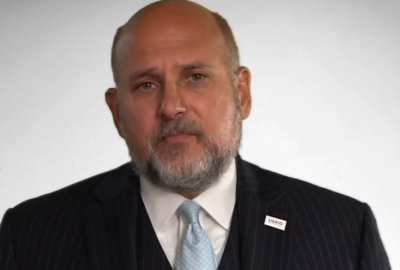
CDC’s system for tracking food-poisoning outbreaks needs some work
The Centers for Disease Control and Prevention have developed sound systems to identify and track multi-state outbreaks of food poisoning.
Best listening experience is on Chrome, Firefox or Safari. Subscribe to Federal Drive’s daily audio interviews on Apple Podcasts or PodcastOne.
One in six Americans is not how many have come down with COVID-19 so far, but it is how many catch foodborne illnesses every year. The Centers for Disease Control and Prevention have developed sound systems to identify and track multi-state outbreaks of food poisoning. But a Government Accountability Office audit found the CDC needs to strengthen its performance assessment system to ensure that program works. For more, the Director of the Natural Resource and Environment team at the GAO, Steve Morris, spoke to Federal Drive with Tom Temin.
Interview transcript:
Tom Temin: Steve, good to have you on.
Steve Morris: Thanks for having me Tom.
Tom Temin: And you were looking at what? Whether CDC can track foodborne illness outbreaks or whether they have a system in place to make sure they’re good at it?
Steve Morris: Essentially what we did was we looked at three different aspects of CDC efforts here to identify and respond to foodborne illness. So we took a hard look at their various roles and responsibilities. Also looked at some of the challenges are facing in terms of identifying and responding to those outbreaks. Also to the extent that CDC evaluates its performance as it pursues its efforts.
Tom Temin: I want to read one sentence from the highlights of the report. And it says that one challenge stems from the increasing clinical use of culture independent diagnostic tests, CIDTs diagnose foodborne illnesses faster and cheaper than traditional methods. But because they do not create DNA fingerprints that can specify a pathogen, they may reduce CDCs ability to identify an outbreak. That sounds contradictory. And so maybe let’s talk about what this new technology or new methodology they’re using actually is, and what some of the problems with it are.
Steve Morris: Sure Tom. I think you hit on a really important point in terms of what we found. So we noted that the use of these new clinical methods is really confronted CDC with a new challenge. And what’s happening is that, and there’s some good news to this. When patients come in with a foodborne illness, there are now new tests that physicians are using to diagnose these folks as it relates to foodborne illness. So they’re using these culture independent diagnostic tests for the last decade or so. And again, the good news there that it’s identifying the foodborne illness diagnosis quicker, more cheaply than traditional methods. The not so good news is that these diagnostics tests do not identify specific DNA information about the pathogens. And that’s the critical point. It’s that key DNA fingerprint that CDC uses to identify potential outbreak. So even though these tests are good in the sense that they’re identifying these illnesses quickly and should be for patients, in terms of CDC using that information across the board to identify potential outbreaks, it’s becoming a challenge for them.
Tom Temin: In other words, they don’t have DNA information on the pathogen that they can compare from location to location to know that there’s a commonality in the outbreak.
Steve Morris: Exactly.
Tom Temin: So what’s the practical effect of that lack? That is to say, maybe they can find, yeah this is foodborne, but they can’t have visibility into how widespread it might be?
Steve Morris: Yeah, I think that’s fair Tom. I mean, I think this is, we’ve categorized this as a challenge for CDC, it makes their job tougher. And so there’s a recognition on that and on their part, that this is something they need to keep their eyes on. They’ve worked internally to come up with a plan to address this challenge. But we’re taking it the next step and we’re really pushing them to develop a plan that identifies the various steps they need to take to deal with this.
Tom Temin: Yeah, because the second part of recognizing a foodborne pathogen is knowing whether this is something that is systemic in the food system, right. So if they can’t do that, then it’s kind of nice to know. Yeah, you’re got you’re sick because of a foodborne illness. But if it’s happening in 10, states, and they can’t find out, then half the purpose of CDC, in a sense is lost.
Steve Morris: Well again, I go back to the that example of it’s good for the patient in the sense that the individual is made aware of the fact that they may have an illness, but from a kind of a broad perspective, connecting the dots across multiple patients, potentially across multiple states, that becomes challenging for CDC.
Tom Temin: And so what does the CDC say about that idea that you recommend that they get around that problem, but that’s a pretty hard prescription, when it comes down to the details?
Steve Morris: Well Tom, we we pointed this out to CDC. And again, they had visibility over this issue, and they’ve talked internally about what they can or can’t do. What we’re making a recommendation that they pursue this to a plan, come up with specific measures on how to mitigate some of these challenges. And CDC agrees and they concurred with the record. commendation,
Tom Temin: And when you recommend in a ways to evaluate performance of their multistate foodborne illness outbreak investigations, what are some of the metrics for performance in this type of activity?
Steve Morris: Oh, that’s a good question. We did take a good look at their efforts to evaluate their efforts to identify and respond to foodborne illness. And, again, there’s some good news here, they have some high level kind of strategic goals for dealing with foodborne illness. But when you take a look at performance assessment, the various components of that, they’re missing the mark on several points. So we pointed out they need to have not just kind of long term strategic goals, but they have to have things on the garden that, for example, they need what we call more focused strategic goals, performance measures to assess their progress to meet those goals, and then also to do an evaluation when the time comes to see how well CDC is performing in this area. And again, that’s something that CDC has acknowledged. And we made the recommendation and they also concurred with the recommendation.
Tom Temin: Do we know or did you even evaluate whether foodborne illness as a phenomenon is on the increase in the United States? Is this something that CDC is going to be confronted with more frequently?
Steve Morris: Yeah, I mean, that’s a strong possibility Tom. Looking at the numbers, the most recent data, there’s been about a doubling of the number of foodborne illness outbreaks over the last five to six years. So you look back to 2016, I believe, or maybe 2018 the latest figures they had, there was about 50 plus outbreaks, that’s about double what was the previous five years. So there is an increase, there’s no indication that this is going to become a smaller problem. If anything, it potentially will be a bigger problem, given the fact that folks are eating more raw unprocessed foods, there’s greater, wider distribution of foods and greater centralization of some of the processing of the food. So the indicators probably point to a trend of increase when it comes to foodborne illness outbreaks.
Tom Temin: And I guess that leads to the question of whether the pandemic could have some kind of contributing factor to the increase in foodborne illnesses with people. There’s delivery mechanisms that add another set of hands and containers and so forth to the delivery system and people preparing more things at home that they might not be used to preparing. Imagine someone trying to make sushi at home on a dirty counter something. Seems like this could be something that you would want to track also, or they would want to track and you would want to track them tracking it.
Steve Morris: Yeah, I mean, I think obviously, with the pandemic, that’s impacting every aspect of our life in society. And this is probably no different. From a CDC perspective, they tell us that they have a pretty good handle in terms of their eye and their resources on this issue. They note that a lot of their folks have been deployed to deal with the pandemic. But the staff on hand is able to deal with this issue. And they also acknowledge that, there’s probably a lot of cases out foodborne illness cases that folks may not be reporting, because they’re not going to see the doctor because of that, because of concerns the COVID. So, again, we’ll see how that plays out. Foodborne illness is a common, costly public health concern and that needs to be paid attention to.
Tom Temin: Alright. Steve Morris is director of the Natural Resources and Environment team at the Government Accountability Office. Thanks so much for joining me.
Steve Morris: Thank you so much Tom.
Copyright © 2025 Federal News Network. All rights reserved. This website is not intended for users located within the European Economic Area.
Tom Temin is host of the Federal Drive and has been providing insight on federal technology and management issues for more than 30 years.
Follow @tteminWFED
Related Stories





